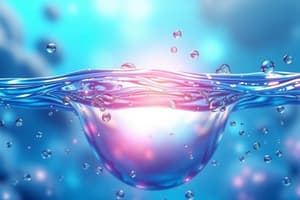Podcast
Questions and Answers
What property of water facilitates the movement of water through xylem vessels in plants?
What property of water facilitates the movement of water through xylem vessels in plants?
- Hydrogen bonding (correct)
- High heat capacity
- Low viscosity
- High vapor pressure
How does water’s high heat capacity benefit living organisms?
How does water’s high heat capacity benefit living organisms?
- It stabilizes internal temperatures. (correct)
- It enhances gas exchange in cells.
- It increases metabolism rates.
- It allows rapid temperature changes.
What is a cooling mechanism that utilizes the property of water requiring high energy to convert from liquid to vapor?
What is a cooling mechanism that utilizes the property of water requiring high energy to convert from liquid to vapor?
- Transpiration (correct)
- Photosynthesis
- Digestion
- Respiration
Why is ice less dense than liquid water, and what is its ecological significance?
Why is ice less dense than liquid water, and what is its ecological significance?
What role does water play in protein folding and cell membrane structure?
What role does water play in protein folding and cell membrane structure?
What is one of the roles of water's high heat capacity in living organisms?
What is one of the roles of water's high heat capacity in living organisms?
Ice is denser than liquid water, allowing it to sink and insulate aquatic life below.
Ice is denser than liquid water, allowing it to sink and insulate aquatic life below.
What mechanism does water provide to help organisms cope with heat?
What mechanism does water provide to help organisms cope with heat?
Water's ability to repel nonpolar substances is essential for __________ structure.
Water's ability to repel nonpolar substances is essential for __________ structure.
Match the properties of water with their respective roles in living organisms:
Match the properties of water with their respective roles in living organisms:
Flashcards
Hydrogen Bonding in Water
Hydrogen Bonding in Water
Attraction between water molecules, increasing water's cohesion and adhesion.
High Heat Capacity of Water
High Heat Capacity of Water
Water absorbs/releases significant heat with little temperature change.
High Energy for Vaporization
High Energy for Vaporization
High energy need to turn water from liquid to vapor.
Ice Density
Ice Density
Signup and view all the flashcards
Water-Nonpolar Interaction
Water-Nonpolar Interaction
Signup and view all the flashcards
Water Cohesion/Adhesion
Water Cohesion/Adhesion
Signup and view all the flashcards
Thermal Buffer
Thermal Buffer
Signup and view all the flashcards
Water's Cooling Effect
Water's Cooling Effect
Signup and view all the flashcards
Protein Folding
Protein Folding
Signup and view all the flashcards
Cell Membrane Structure
Cell Membrane Structure
Signup and view all the flashcards
Study Notes
Hydrogen Bonding in Water
- Hydrogen bonding creates an attraction between water molecules, enhancing cohesion and adhesion.
- This property aids in the transport of water through xylem vessels in plants, enabling efficient nutrient and water distribution.
- Water droplets are formed due to hydrogen bonding, playing a crucial role in processes like transpiration, essential for maintaining cellular structure in plants.
High Heat Capacity of Water
- Water exhibits high heat capacity, allowing it to absorb and release significant amounts of heat with minimal temperature changes.
- This property is vital for temperature regulation, helping stabilize internal temperatures in organisms and their environments.
- Acts as a thermal buffer in aquatic habitats, moderating temperature fluctuations and providing a stable environment for marine life.
High Energy Requirement for Vaporization
- A large amount of energy is required to convert water from liquid to vapor, which is essential for various cooling mechanisms.
- Evaporation acts as a cooling process for organisms, exemplified by sweating in animals and transpiration in plants.
- This property is critical for water loss management, helping regulate water balance during metabolic activities.
Density of Ice vs. Liquid Water
- Ice has a lower density than liquid water due to its unique crystalline structure, which forms a lattice that occupies more space.
- This property provides insulation, as ice floats on liquid water, protecting aquatic life from extreme cold conditions.
- The density difference impacts water bodies, influencing seasonal cycles and ecosystem dynamics.
Interaction of Water with Nonpolar Substances
- Nonpolar substances tend to aggregate in water to minimize their contact with it, a behavior driven by hydrophobic interactions.
- Protein folding is influenced by this property, as hydrophobic regions of proteins cluster inward, facilitating the formation of functional structures.
- The structure of cell membranes is determined by this behavior, where hydrophobic tails of phospholipids face inward while hydrophilic heads face outward, ensuring selective permeability.
Hydrogen Bonding in Water
- Hydrogen bonding creates an attraction between water molecules, enhancing cohesion and adhesion.
- This property aids in the transport of water through xylem vessels in plants, enabling efficient nutrient and water distribution.
- Water droplets are formed due to hydrogen bonding, playing a crucial role in processes like transpiration, essential for maintaining cellular structure in plants.
High Heat Capacity of Water
- Water exhibits high heat capacity, allowing it to absorb and release significant amounts of heat with minimal temperature changes.
- This property is vital for temperature regulation, helping stabilize internal temperatures in organisms and their environments.
- Acts as a thermal buffer in aquatic habitats, moderating temperature fluctuations and providing a stable environment for marine life.
High Energy Requirement for Vaporization
- A large amount of energy is required to convert water from liquid to vapor, which is essential for various cooling mechanisms.
- Evaporation acts as a cooling process for organisms, exemplified by sweating in animals and transpiration in plants.
- This property is critical for water loss management, helping regulate water balance during metabolic activities.
Density of Ice vs. Liquid Water
- Ice has a lower density than liquid water due to its unique crystalline structure, which forms a lattice that occupies more space.
- This property provides insulation, as ice floats on liquid water, protecting aquatic life from extreme cold conditions.
- The density difference impacts water bodies, influencing seasonal cycles and ecosystem dynamics.
Interaction of Water with Nonpolar Substances
- Nonpolar substances tend to aggregate in water to minimize their contact with it, a behavior driven by hydrophobic interactions.
- Protein folding is influenced by this property, as hydrophobic regions of proteins cluster inward, facilitating the formation of functional structures.
- The structure of cell membranes is determined by this behavior, where hydrophobic tails of phospholipids face inward while hydrophilic heads face outward, ensuring selective permeability.
Studying That Suits You
Use AI to generate personalized quizzes and flashcards to suit your learning preferences.
Description
Explore the unique properties of water, including hydrogen bonding and high heat capacity, and their critical roles in living organisms. This quiz covers how these properties facilitate water transport in plants and stabilize internal temperatures, impacting cellular structure and overall environmental conditions.




